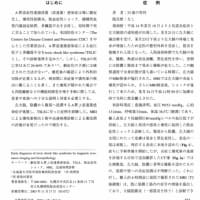The L-type calcium channel in the heart: the beat goes on
Ilona Bodi, Gabor Mikala, Sheryl E. Koch, Shahab A. Akhter, and Arnold Schwartz
Sydney Ringer would be overwhelmed today by the implications of his simple experiment performed over 120 years ago showing that the heart would not beat in the absence of Ca2+. Fascination with the role of Ca2+ has proliferated into all aspects of our understanding of normal cardiac function and the progression of heart disease, including induction of cardiac hypertrophy, heart failure, and sudden death. This review examines the role of Ca2+ and the L-type voltage-dependent Ca2+ channels in cardiac disease.
When Sydney Ringer (1) discovered the vital role of Ca2+ in the heart, investigations took a leap forward and have continued unabated (2). Austrian scientist Otto Loewi, best known for his work on autonomic transmitters and discovery of "chemical vagusstoff," recognized the connection between digitalis and Ca2+ in 1917–1918. Although he always believed that Ca2+ was the key to understanding life’s processes, the Nobel Prize in Physiology and Medicine was awarded to Loewi and Sir Henry Hallett Dale in 1936 for their studies on neurotransmitters.
Ca2+ is the link in excitation-contraction (EC) coupling (Figure 1), which starts during the upstroke of the action potential (AP) and causes the opening of the L-type voltage-dependent Ca2+ channel (L-VDCC). Interest in high-voltage–activated L-VDCCs began with biochemical and continued with molecular characterizations, culminating in the cloning of the pore-forming 1 subunit and the auxiliary channel subunit 2/ from rabbit skeletal muscle (3-5). Although the L-VDCC subunits are most abundant in fast skeletal transverse tubules, Ca2+ influx is not required for contraction in skeletal muscle, unlike cardiac muscle, which requires Ca2+ entry with each beat and triggers Ca2+ release from the sarcoplasmic reticulum (SR) via Ca2+-release channels, e.g., ryanodine receptor 2 (RyR2). This amplifying process, termed Ca2+-induced Ca2+ release (CICR) by A. Fabiato, causes a rapid increase in intracellular Ca2+ concentration ([Ca2+]i) (from 100 nM to 1 µM) to a level required for optimal binding of Ca2+ to troponin C and induction of contraction (2). There is a close correlation between activation of the L-type Ca2+ current (ICa,L) and cardiac contraction. Contraction is followed by Ca2+ release from troponin C and its reuptake by the SR via activation of the SR Ca2+-ATPase 2a (SERCA2a) Ca2+ pump in addition to extrusion across the sarcolemma via the Na+/Ca2+ exchanger (NCX). In the human heart under resting conditions, the time required for cardiac myocyte depolarization, Ca2+-induced Ca2+ release, contraction, relaxation, and recovery is 600 ms. This process occurs approximately 70 times a minute or over 2 billion times in the average lifespan. Ca2+ is also required for maintenance of cell integrity and gene expression (6) relevant to the growth and development of the embryonic heart (7). L-VDCCs are regulated by the adrenergic nervous system and may interact with G protein–coupled receptors (8). 

Model for CDI and VDI. (A) Ca2+ channel at rest when no Ca2+ influx occurs. At rest, in the absence of Ca2+, the CaM binds to peptide A, located between the EF hand and the IQ motif of the C terminus of the L-VDCC 1C subunit. In response to a depolarizing stimulus, Ca2+ enters through the L-VDCC and binds to CaM. In the open Ca2+ channel state, the EF hand prevents structural conformation of the I–II loop required to block Ca2+ entry through the channel pore (B). In addition, the hydrophobic I1654 in the IQ motif is a stabilizing factor preventing the occlusion of the pore. Upon elevation of [Ca2+]i (depolarization), the Ca2+/CaM complex undergoes the Ca2+-dependent conformational change that relieves the inhibition of EF hand, permitting the I–II loop to interact with the pore and accelerate the fast inactivation process (C). The graph shows representative ICa traces evoked by depolarization from –50 mV to +40 mV, as labeled, using –60 mV as holding potential. (D) Involvement of CaM and CaMKII in the facilitation process. CaMKII enhances the ICa through phosphorylation of L-VDCC. We show murine whole-cell ICa generated from paired depolarizing pulses (–60 mV ± 10 mV at 0.5 Hz) representing Ca2+-dependent facilitation (graph).
最新の画像[もっと見る]
-
 お知らせ 世界敗血症デー 京都 2024
1ヶ月前
お知らせ 世界敗血症デー 京都 2024
1ヶ月前
-
 お知らせ 世界敗血症デー 京都 2024
1ヶ月前
お知らせ 世界敗血症デー 京都 2024
1ヶ月前
-
 お知らせ 世界敗血症デー 京都 2024
1ヶ月前
お知らせ 世界敗血症デー 京都 2024
1ヶ月前
-
 お知らせ 世界敗血症デー 京都 2024
1ヶ月前
お知らせ 世界敗血症デー 京都 2024
1ヶ月前
-
 お知らせ 世界敗血症デー 京都 2024
1ヶ月前
お知らせ 世界敗血症デー 京都 2024
1ヶ月前
-
 セミナーのお知らせ 多発外傷カンファレンス with デューク大学
2ヶ月前
セミナーのお知らせ 多発外傷カンファレンス with デューク大学
2ヶ月前
-
 執筆紹介 麻酔科学と救急医学 ー場の成長と発展のためにー 救急医療 人道の道 JAPAN and the World
2ヶ月前
執筆紹介 麻酔科学と救急医学 ー場の成長と発展のためにー 救急医療 人道の道 JAPAN and the World
2ヶ月前
-
 執筆紹介 麻酔科学と救急医学 ー場の成長と発展のためにー 救急医療 人道の道 JAPAN and the World
2ヶ月前
執筆紹介 麻酔科学と救急医学 ー場の成長と発展のためにー 救急医療 人道の道 JAPAN and the World
2ヶ月前
-
 執筆紹介 麻酔科学と救急医学 ー場の成長と発展のためにー 救急医療 人道の道 JAPAN and the World
2ヶ月前
執筆紹介 麻酔科学と救急医学 ー場の成長と発展のためにー 救急医療 人道の道 JAPAN and the World
2ヶ月前
-
 救急・集中治療 人食いバクテリアの診断と治療
7ヶ月前
救急・集中治療 人食いバクテリアの診断と治療
7ヶ月前
「論文紹介 細胞内情報伝達」カテゴリの最新記事
 文献紹介 ORAI-1 筋小胞体蛋白
文献紹介 ORAI-1 筋小胞体蛋白 細胞内情報伝達 Glucocorticoid-induced Myopathy
細胞内情報伝達 Glucocorticoid-induced Myopathy VHRG ジャーナルクラブ 2011年9月討論 TNF death signal;TIMP/TACE pathwayの関...
VHRG ジャーナルクラブ 2011年9月討論 TNF death signal;TIMP/TACE pathwayの関... 総説 Nature Reviews Immunology 2009; 9, 465-479
総説 Nature Reviews Immunology 2009; 9, 465-479 J. Clin. Invest. 115:3527-3535 (2005).
J. Clin. Invest. 115:3527-3535 (2005). L型カルシウムチャネル J. Clin. Invest. 115:3306-3317, 2005
L型カルシウムチャネル J. Clin. Invest. 115:3306-3317, 2005 AJP Heart Circ Physiol 289: H1635-H1642, 2005
AJP Heart Circ Physiol 289: H1635-H1642, 2005 AJP Heart Circ Physiol 289: H1594-H1603, 2005
AJP Heart Circ Physiol 289: H1594-H1603, 2005 AJP Heart Circ Physiol 289: H1488-H1496, 2005
AJP Heart Circ Physiol 289: H1488-H1496, 2005 Akt1 J. Clin. Invest. 2005 115: 2059-2064
Akt1 J. Clin. Invest. 2005 115: 2059-2064

















